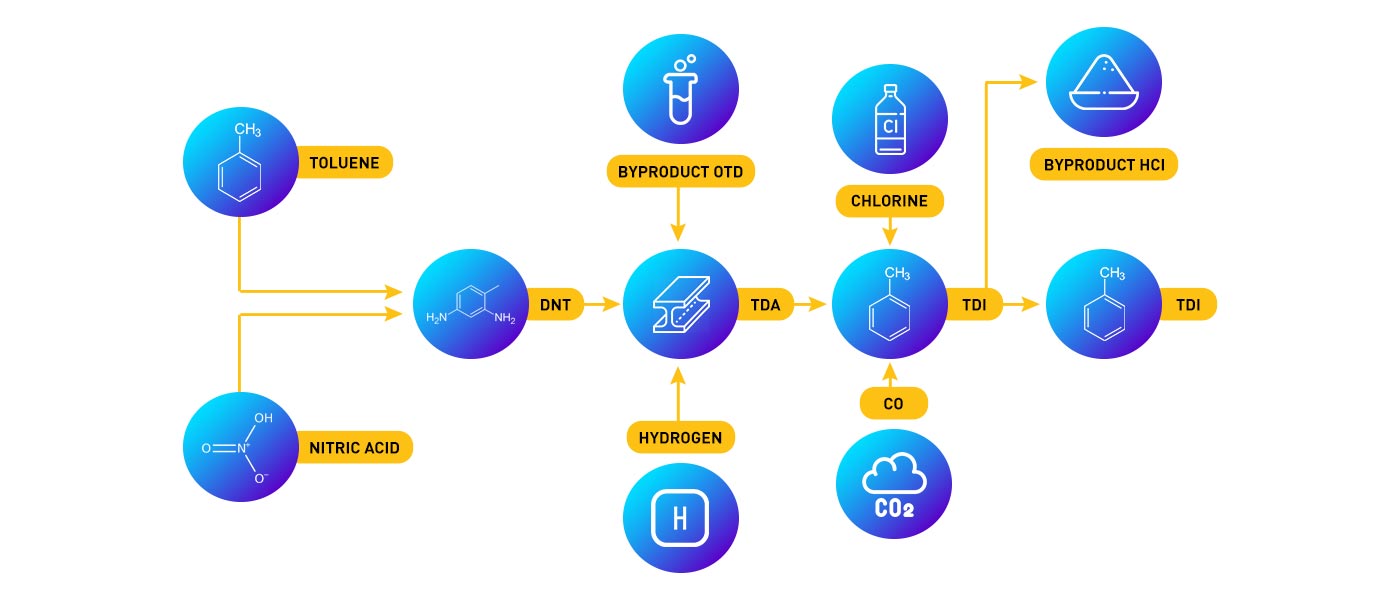
TDI is produced from Toluene via nitration to Dinitrotoluene (DNT). DNT is continuously hydrogenated to Toluenediamine (TDA). The unwanted ortho isomers (OTD) are removed by distillation to give meta Toluenediamine (MTD). The OTD is of good enough quality to be sold externally. The MTD is phosgenated in a solvent to produce crude Toluene diisocyanate (TDI). Excess phosgene and solvent is recovered and recycled. The by-product HCl is purified to a quality sufficient for oxidation to chlorine which is used in the synthesis of phosgene. Alternative uses of the purified HCl gas is as raw material in a VCM plant or absorption in water to produce hydrochloric acid for external sale. Heavy impurities (TDI-tar) are removed from the crude TDI before it is finally distilled to give high quality TDI product.
Dinitrotoluene – DNT
Dinitrotoluene isomer mixture (DNT, CAS No. 25321-14-6) is produced by continuous nitration of toluene by nitric acid using sulfuric acid as the catalyst/solvent. The process uses the well-known and proprietary Pump Nitration unit and it is performed in two stages with production of intermediate Mononitrotoluene (MNT) in the first stage. The MNT is further nitrated to DNT in stage two using higher temperature and stronger sulfuric acid. The acid flows counter-current to the flow of organics and from the first stage a spent acid (SPA) is produced. From the SPA, the dissolved organics and the excess nitric acid is recovered and recycled to the process, resulting in high yield and low consumption rates. Also gaseous NOx is recovered and recycled to the process. Finally the water produced in the nitration is removed from the sulfuric acid so it can be reused in the nitration. Only a small amount of make-up sulfuric acid must be added to compensate the small losses.
A main feature of the Pump Nitration technology is very high safety as only very little reactive organics are present in the system. The nitration rate is very fast and the heat of nitration is immediately absorbed by the inert sulfuric acid, resulting in a modest adiabatic temperature increase of approximately 10 °C. This heat is removed in a cooler and the organic product is separated before the acid is returned to the nitration loop. The process is extremely stable giving excellent and uniform quality. Several interlocks and safety systems guarantee that the process is shut down in a safe way in case of a process upset. The reaction is ceased within a few seconds when feed of raw materials is stopped.
Toluenediamine – TDA
Toluenediamine (TDA) is produced by hydrogenation of DNT in the presence of a proprietary catalyst in a continuous well stirred tank reactor. The resulting TDA-water mixture is used as the solvent for the process. After filtering off and return of the catalyst the water produced as by-product is distilled off followed by removal of the ortho isomers (OTD, CAS No. 26966-75-6) by distillation. The OTD can be sold or incinerated. The bottom stream is called MTD (CAS No. 25376-45-8) and it contains an 80/20 mixture of 2,4- and 2,6-TDA. This mixture is the key raw material in the production of TDI. The Chematur TDA process guarantees complete hydrogenation of DNT with a minímum production of by-products.
Toluene diisocyanat – TDI
Toluene diisocyante (TDI, CAS no 26471-62-5) is produced by phosgenation of MTD in a solvent. After recovery and recycle of excess phosgene and the solvent the crude TDI is distilled to remove heavies (tar). From the tar the remaining TDI is recovered to maximize yield. The resulting TDI-tar is removed as a dry solid material which is incinerated. After a final distillation the end product TDI is sent to storage for sale.